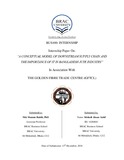A conceptual model of downstream supply chain and the importance of it in Bangladesh Jute Industry

View/
Date
2018-11Publisher
BRAC UniversityAuthor
Ashif, Mehedi AhsanMetadata
Show full item recordAbstract
Jute, being an environment-friendly crop has engrossed a widespread interest globally in recent times. As a subsequent result, the jute producing countries like Bangladesh has emerged as one of the potential market to fulfill these requirements. Nonetheless, it is a remorseful fact that in Bangladesh for the jute industry; deficiency of proper and effective supply chain management in both the upstream and downstream is the chief factor for the stagnant growth of the jute industry. Therefore, this paper has concentrated on the downstream supply chain of the jute industry and thus, a “conceptual model” of the supply chain that includes all the processes and the stages of the downstream is proposed in the paper. Moreover, the complications of these supply chain stages are highlighted so that they can be scrutinized to aid the related industry. Which in return would elucidate the way to find essential solutions. Besides, the essence of the “outsourcing” in the composite jute mills are also an imperative factor that this research has focused. Most of the mills in jute industry do not possess all the obligatory facilities thus in almost all of the scenarios they need to depend on and outsource the facilities that are absent in their own factories from the small factories or mills having the efficiencies in different specific processes. For instance of this small factories: some may have only the efficiency only on spinning facility, others might have only the expertise of weaving facility and this could be the cases in other facilities as well likewise: dying, laminating, printing, sewing etc. Furthermore, few other main reasons for the interruption of the free-flowing growth of this jute industry are the low-productivity of the machines along with the workers who are engaged in the manufacturing and production processes. As a response of these, prevailing problems several ways and solutions are also discoursed in the research work: new and upgraded machineries should be installed in the jute mills, government should pave a congenial environment for the suppliers, manufacturers of these jute and jute diversified products so that all the parties can have their requisite profits in their respective areas, again the workers are also needed to be provided with up to date training so that they can cope with the current demand of the market. Above all, these research paper would give the overview of the whole downstream supply chain that starts with the composite jute mills and ends up in the customers of the jute and jute diversified products. As a result, the necessary steps to be undergone can be figured out which would eventually lead to the prosperous and stiff growth of the jute industry as a whole.
